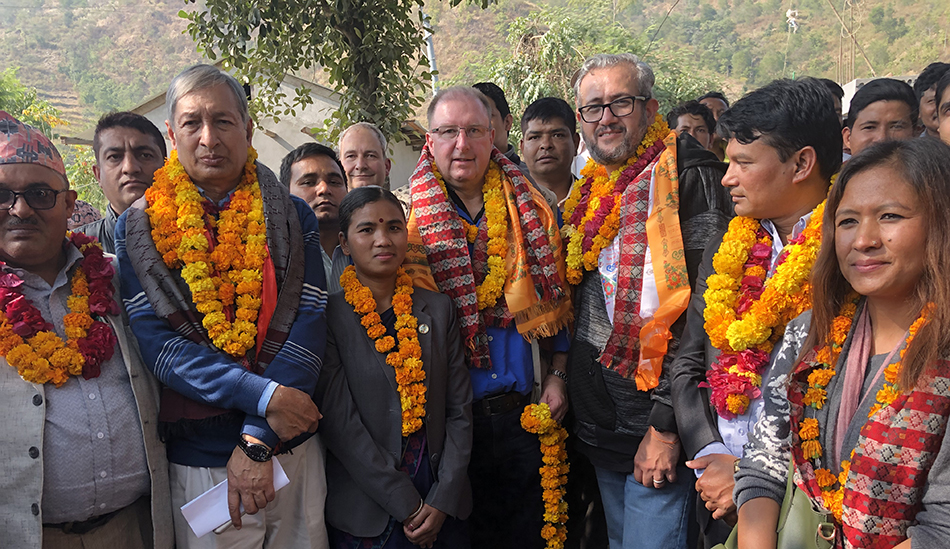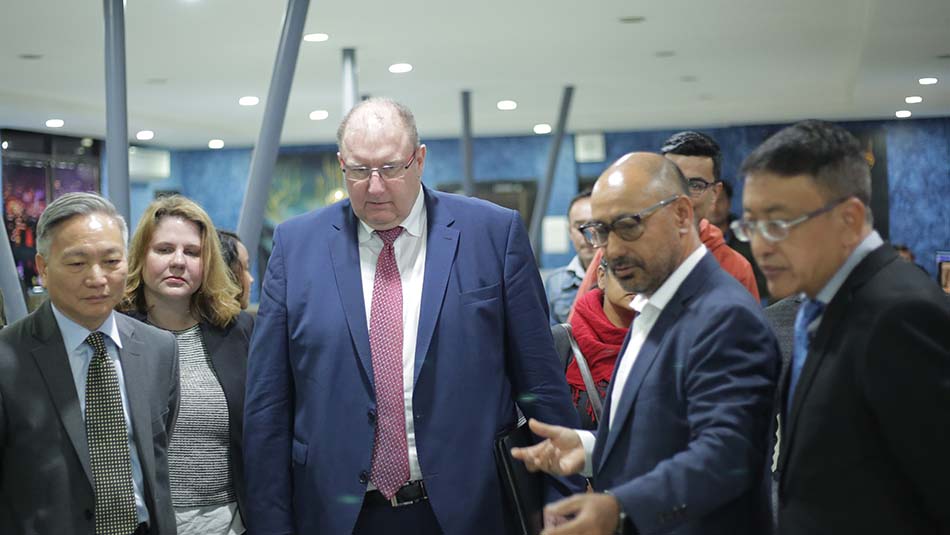
KATHMANDU, November 18, 2018— World Bank Vice President for South Asia Region, Hartwig Schafer, reiterated the World Bank Group’s commitment to support Nepal in its ambitious transition to federalism, as he concluded a five-day visit to the country. 
During his meeting with Prime Minister KP Sharma Oli, Schafer congratulated the government’s visionary goal of reaching middle-income country status by 2030, reaffirmed the World Bank’s commitment to support government priorities, and to help the country raise additional finance from a broader range of sources. In his meeting with Finance Minister Dr. Yuba Raj Khatiwada, Mr. Schafer also discussed further support to the federalism transition, as well as the planned International Investors’ Conference in 2019 in support of Nepal’s agenda to crowd in private finance for development.
“With a stable government that has prioritized broad-based reforms and private sector-driven growth, I am positive that Nepal can achieve higher growth rates for the next several years. To sustain such growth, we want to help Nepal mobilize investments from sources that go beyond traditional development finance. We call this approach Maximizing Finance for Development. Private sector investment will only come if there is a transparent, conducive policy environment,” he said, “Nepal is one of the first countries where we are approaching this in a systematic way with the World Bank, IFC and MIGA coming in and helping to provide a platform for private investments in the energy, technology, and other sectors. This will also create jobs for more and more Nepalis, which is the need of the hour.”
The Vice President also had a joint field visit with Finance Minister Dr. Yuba Raj Khatiwada and Minister for Energy, Water Resources and Irrigation Barsha Man Pun to discuss the potential of tourism, hydropower and private sector investment in the country. The team visited Solukhumbu District and Sankhuwasabha District before seeing houses being rebuilt after the earthquake in the Majhi settlement of Gaikhura in Manthali Municipality, Ramechhap.
Walking through the houses being rebuilt, Mr. Schafer met members of local communities, commending their resilience and efforts to build back better after the earthquake. He also met elected members of parliament and local level representatives. “It is heartening to see the collective effort of so many actors to ensure that people’s homes and lives are rebuilt,” Schafer said. “We must pick up the pace of reconstruction, and also ensure that disaster risk reduction measures are put in place to deal with future contingencies.” The World Bank has provided a credit of $500 million to the Government of Nepal through the Earthquake Housing Reconstruction Project.
In Kathmandu, Mr. Schafer participated in the launch of a joint report of the World Bank Group entitled “Country Private Sector Diagnostic: Creating Markets in Nepal”. He was also part of the signing of two agreements between the Government of Nepal and World Bank. The agreements, totaling US$ 155.7 million, will be invested in the construction and maintenance of safe, resilient and cost-effective bridges in Nepal, and in improving food security of vulnerable households and communities. In his first visit to Nepal as the World Bank Vice President for South Asia, Mr. Schafer also met with opinion leaders, senior government officials and civil society representatives. In engaging with the private sector, he visited Saral Urja Nepal, the investee clients of Business Oxygen (BO2), an IFC SME-Venture Fund, and Incessant Rain Animation Studios, a state-of-the-art animation and visual effects studio.
After his interactions with the team at Incessant Rain, Mr. Schafer commented, “I really enjoyed this opportunity to visit an enterprise that is nurturing the artistic and creative talents of the Nepalese youth. With a world class facility that provides services to well- known international clients, organizations like this play an important role in putting Nepal on the map as an outsourcing destination. Apart from contributing to the economic growth through exports and job creation, it is a pleasure to see a home-grown company that promotes the country’s rich cultural heritage and diversity. This is the kind of future we want for the private sector in Nepal, and the World Bank is committed to support this vision.”
In Nepal, the World Bank Group (WBG) includes the International Development Association (IDA), the concessionary lending arm; the International Finance Corporation (IFC), the private sector arm; and the Multilateral Investment Guarantee Agency (MIGA), the investment risk insurance arm.
The World Bank currently supports 27 active investment projects in Nepal with $3.81 billion dollars in commitments from IDA and trust funds of which significant proportion is against Development Policy Credits for policy reforms in the areas of fiscal decentralization, financial sector and energy sector. The indicative resources available under IDA18 (FY2018-2020) are about $1.39 billion, including $300 million from the IDA Risk Mitigation Regime. IFC aims to commit about $800 million to $1.2 billion over the five-year period (FY19 to FY23). MIGA is actively seeking opportunities to support foreign private investment into Nepal. IFC and MIGA may make use of the IDA IFC/MIGA Private Sector Window (PSW) and the MIGA Guarantee Facility to underwrite eligible projects.
The World Bank Group (WBG) fielded its first economic mission to Nepal in 1963 to assess the country’s development prospects and challenges. It approved its first credit in 1969 for a telecommunications project. Since then, the World Bank has provided Nepal $4.75 billion in assistance ($3.48 billion in credits and $1.27 billion in grants). 
 वरिष्ठ अभिनेता कृष्ण मल्ल नेपाल फिल्म सोसाइटीको अध्यक्षमा निर्विरोध निर्वाचित
वरिष्ठ अभिनेता कृष्ण मल्ल नेपाल फिल्म सोसाइटीको अध्यक्षमा निर्विरोध निर्वाचित
 समष्टिगत विषयवस्तुको चित्रण ‘चियर्स’ कथासङ्ग्रह
समष्टिगत विषयवस्तुको चित्रण ‘चियर्स’ कथासङ्ग्रह
 अनेसास कोलोराडो च्याप्टरको अध्यक्षमा किरण अधिकारी
अनेसास कोलोराडो च्याप्टरको अध्यक्षमा किरण अधिकारी
 सुनको मूल्य एकैदिन तोलामा २२ सयले घट्यो
सुनको मूल्य एकैदिन तोलामा २२ सयले घट्यो
 ‘पूर्णबहादुरको सारङ्गी’ बन्यो सबैभन्दा धेरै कमाउने चलचित्र, १४ दिनमा २७ करोड कमायो
‘पूर्णबहादुरको सारङ्गी’ बन्यो सबैभन्दा धेरै कमाउने चलचित्र, १४ दिनमा २७ करोड कमायो
 निर्देशक/कलाकार माओत्से गुरुङसँग “अग्निदहन” फिल्मलाई लिएर गरिएको छोटो कुराकानी
निर्देशक/कलाकार माओत्से गुरुङसँग “अग्निदहन” फिल्मलाई लिएर गरिएको छोटो कुराकानी
 गोपी मैनालीको विशृङ्खलित सपनाले देखाएको स्वप्निल सार
गोपी मैनालीको विशृङ्खलित सपनाले देखाएको स्वप्निल सार